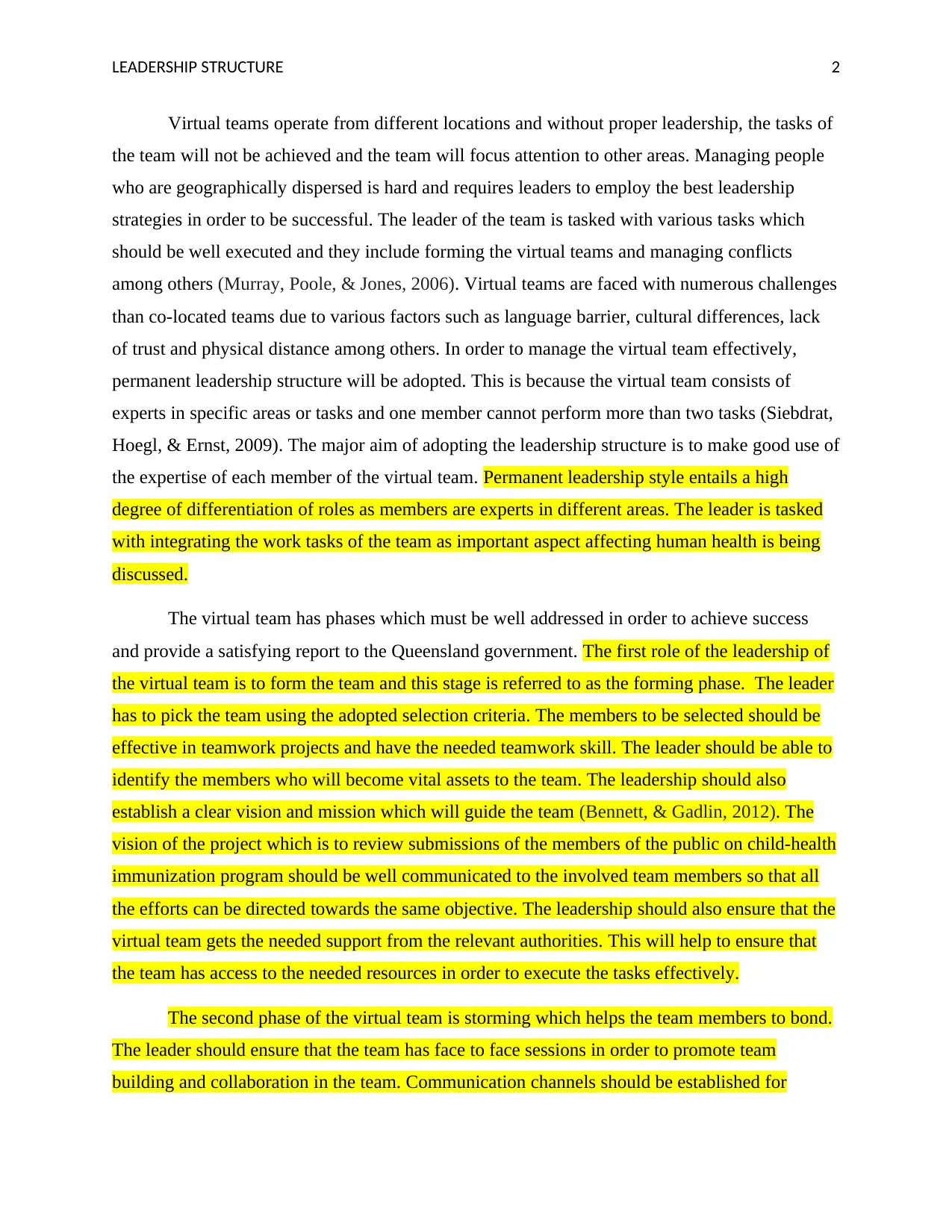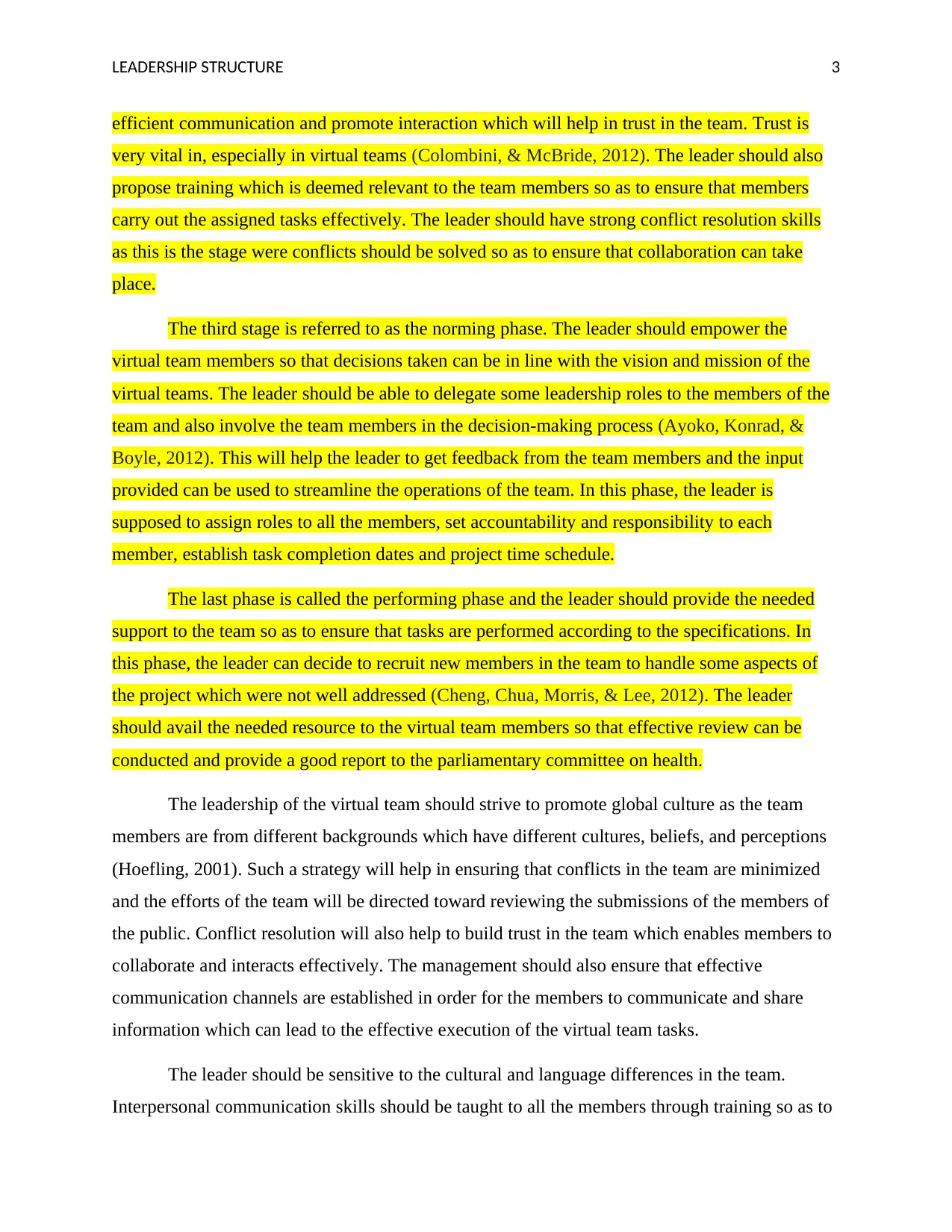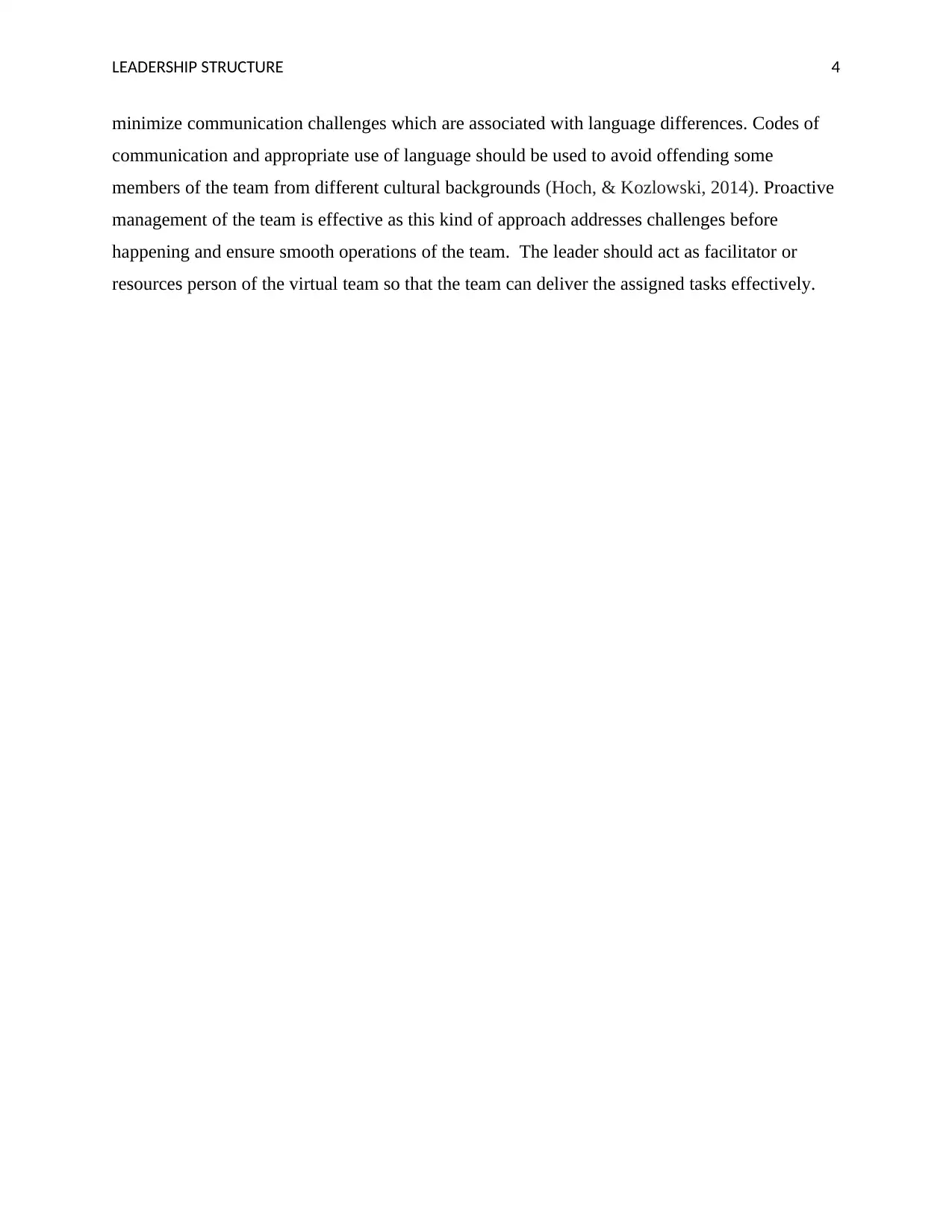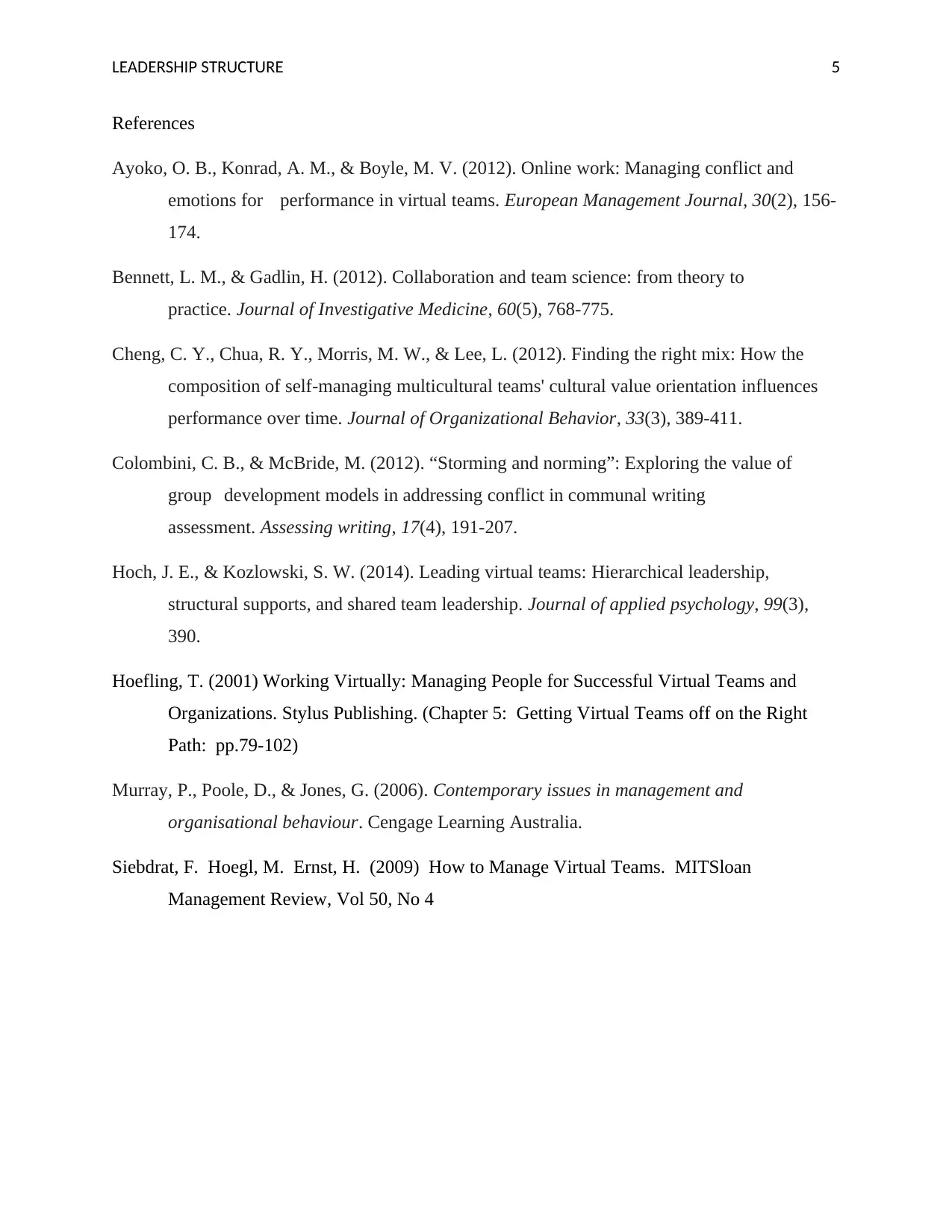BISM3207 - Leadership in Virtual Teams: Structure and Challenges
VerifiedAdded on 2023/06/03
|5
|1391
|153
Report
AI Summary
This report examines leadership structures within virtual teams, particularly in the context of a review of Queensland’s child-health immunization program. It emphasizes the challenges faced by virtual teams, such as geographical dispersion, language barriers, and lack of trust, and advocates for a permanent leadership structure to leverage the expertise of individual team members. The report details the various phases of virtual team development—forming, storming, norming, and performing—and the corresponding leadership roles required at each stage. Key aspects of effective virtual team leadership include establishing a clear vision, fostering team building through face-to-face sessions, promoting open communication and trust, empowering team members, and proactively managing conflicts. The report also highlights the importance of promoting a global culture within the team, being sensitive to cultural and language differences, and acting as a facilitator to ensure the successful completion of tasks and delivery of a comprehensive report.

LEADERSHIP STRUCTURE 1
Leadership structure
Student Name
Institution
Leadership structure
Student Name
Institution
Paraphrase This Document
Need a fresh take? Get an instant paraphrase of this document with our AI Paraphraser

LEADERSHIP STRUCTURE 2
Virtual teams operate from different locations and without proper leadership, the tasks of
the team will not be achieved and the team will focus attention to other areas. Managing people
who are geographically dispersed is hard and requires leaders to employ the best leadership
strategies in order to be successful. The leader of the team is tasked with various tasks which
should be well executed and they include forming the virtual teams and managing conflicts
among others (Murray, Poole, & Jones, 2006). Virtual teams are faced with numerous challenges
than co-located teams due to various factors such as language barrier, cultural differences, lack
of trust and physical distance among others. In order to manage the virtual team effectively,
permanent leadership structure will be adopted. This is because the virtual team consists of
experts in specific areas or tasks and one member cannot perform more than two tasks (Siebdrat,
Hoegl, & Ernst, 2009). The major aim of adopting the leadership structure is to make good use of
the expertise of each member of the virtual team. Permanent leadership style entails a high
degree of differentiation of roles as members are experts in different areas. The leader is tasked
with integrating the work tasks of the team as important aspect affecting human health is being
discussed.
The virtual team has phases which must be well addressed in order to achieve success
and provide a satisfying report to the Queensland government. The first role of the leadership of
the virtual team is to form the team and this stage is referred to as the forming phase. The leader
has to pick the team using the adopted selection criteria. The members to be selected should be
effective in teamwork projects and have the needed teamwork skill. The leader should be able to
identify the members who will become vital assets to the team. The leadership should also
establish a clear vision and mission which will guide the team (Bennett, & Gadlin, 2012). The
vision of the project which is to review submissions of the members of the public on child-health
immunization program should be well communicated to the involved team members so that all
the efforts can be directed towards the same objective. The leadership should also ensure that the
virtual team gets the needed support from the relevant authorities. This will help to ensure that
the team has access to the needed resources in order to execute the tasks effectively.
The second phase of the virtual team is storming which helps the team members to bond.
The leader should ensure that the team has face to face sessions in order to promote team
building and collaboration in the team. Communication channels should be established for
Virtual teams operate from different locations and without proper leadership, the tasks of
the team will not be achieved and the team will focus attention to other areas. Managing people
who are geographically dispersed is hard and requires leaders to employ the best leadership
strategies in order to be successful. The leader of the team is tasked with various tasks which
should be well executed and they include forming the virtual teams and managing conflicts
among others (Murray, Poole, & Jones, 2006). Virtual teams are faced with numerous challenges
than co-located teams due to various factors such as language barrier, cultural differences, lack
of trust and physical distance among others. In order to manage the virtual team effectively,
permanent leadership structure will be adopted. This is because the virtual team consists of
experts in specific areas or tasks and one member cannot perform more than two tasks (Siebdrat,
Hoegl, & Ernst, 2009). The major aim of adopting the leadership structure is to make good use of
the expertise of each member of the virtual team. Permanent leadership style entails a high
degree of differentiation of roles as members are experts in different areas. The leader is tasked
with integrating the work tasks of the team as important aspect affecting human health is being
discussed.
The virtual team has phases which must be well addressed in order to achieve success
and provide a satisfying report to the Queensland government. The first role of the leadership of
the virtual team is to form the team and this stage is referred to as the forming phase. The leader
has to pick the team using the adopted selection criteria. The members to be selected should be
effective in teamwork projects and have the needed teamwork skill. The leader should be able to
identify the members who will become vital assets to the team. The leadership should also
establish a clear vision and mission which will guide the team (Bennett, & Gadlin, 2012). The
vision of the project which is to review submissions of the members of the public on child-health
immunization program should be well communicated to the involved team members so that all
the efforts can be directed towards the same objective. The leadership should also ensure that the
virtual team gets the needed support from the relevant authorities. This will help to ensure that
the team has access to the needed resources in order to execute the tasks effectively.
The second phase of the virtual team is storming which helps the team members to bond.
The leader should ensure that the team has face to face sessions in order to promote team
building and collaboration in the team. Communication channels should be established for

LEADERSHIP STRUCTURE 3
efficient communication and promote interaction which will help in trust in the team. Trust is
very vital in, especially in virtual teams (Colombini, & McBride, 2012). The leader should also
propose training which is deemed relevant to the team members so as to ensure that members
carry out the assigned tasks effectively. The leader should have strong conflict resolution skills
as this is the stage were conflicts should be solved so as to ensure that collaboration can take
place.
The third stage is referred to as the norming phase. The leader should empower the
virtual team members so that decisions taken can be in line with the vision and mission of the
virtual teams. The leader should be able to delegate some leadership roles to the members of the
team and also involve the team members in the decision-making process (Ayoko, Konrad, &
Boyle, 2012). This will help the leader to get feedback from the team members and the input
provided can be used to streamline the operations of the team. In this phase, the leader is
supposed to assign roles to all the members, set accountability and responsibility to each
member, establish task completion dates and project time schedule.
The last phase is called the performing phase and the leader should provide the needed
support to the team so as to ensure that tasks are performed according to the specifications. In
this phase, the leader can decide to recruit new members in the team to handle some aspects of
the project which were not well addressed (Cheng, Chua, Morris, & Lee, 2012). The leader
should avail the needed resource to the virtual team members so that effective review can be
conducted and provide a good report to the parliamentary committee on health.
The leadership of the virtual team should strive to promote global culture as the team
members are from different backgrounds which have different cultures, beliefs, and perceptions
(Hoefling, 2001). Such a strategy will help in ensuring that conflicts in the team are minimized
and the efforts of the team will be directed toward reviewing the submissions of the members of
the public. Conflict resolution will also help to build trust in the team which enables members to
collaborate and interacts effectively. The management should also ensure that effective
communication channels are established in order for the members to communicate and share
information which can lead to the effective execution of the virtual team tasks.
The leader should be sensitive to the cultural and language differences in the team.
Interpersonal communication skills should be taught to all the members through training so as to
efficient communication and promote interaction which will help in trust in the team. Trust is
very vital in, especially in virtual teams (Colombini, & McBride, 2012). The leader should also
propose training which is deemed relevant to the team members so as to ensure that members
carry out the assigned tasks effectively. The leader should have strong conflict resolution skills
as this is the stage were conflicts should be solved so as to ensure that collaboration can take
place.
The third stage is referred to as the norming phase. The leader should empower the
virtual team members so that decisions taken can be in line with the vision and mission of the
virtual teams. The leader should be able to delegate some leadership roles to the members of the
team and also involve the team members in the decision-making process (Ayoko, Konrad, &
Boyle, 2012). This will help the leader to get feedback from the team members and the input
provided can be used to streamline the operations of the team. In this phase, the leader is
supposed to assign roles to all the members, set accountability and responsibility to each
member, establish task completion dates and project time schedule.
The last phase is called the performing phase and the leader should provide the needed
support to the team so as to ensure that tasks are performed according to the specifications. In
this phase, the leader can decide to recruit new members in the team to handle some aspects of
the project which were not well addressed (Cheng, Chua, Morris, & Lee, 2012). The leader
should avail the needed resource to the virtual team members so that effective review can be
conducted and provide a good report to the parliamentary committee on health.
The leadership of the virtual team should strive to promote global culture as the team
members are from different backgrounds which have different cultures, beliefs, and perceptions
(Hoefling, 2001). Such a strategy will help in ensuring that conflicts in the team are minimized
and the efforts of the team will be directed toward reviewing the submissions of the members of
the public. Conflict resolution will also help to build trust in the team which enables members to
collaborate and interacts effectively. The management should also ensure that effective
communication channels are established in order for the members to communicate and share
information which can lead to the effective execution of the virtual team tasks.
The leader should be sensitive to the cultural and language differences in the team.
Interpersonal communication skills should be taught to all the members through training so as to
⊘ This is a preview!⊘
Do you want full access?
Subscribe today to unlock all pages.

Trusted by 1+ million students worldwide

LEADERSHIP STRUCTURE 4
minimize communication challenges which are associated with language differences. Codes of
communication and appropriate use of language should be used to avoid offending some
members of the team from different cultural backgrounds (Hoch, & Kozlowski, 2014). Proactive
management of the team is effective as this kind of approach addresses challenges before
happening and ensure smooth operations of the team. The leader should act as facilitator or
resources person of the virtual team so that the team can deliver the assigned tasks effectively.
minimize communication challenges which are associated with language differences. Codes of
communication and appropriate use of language should be used to avoid offending some
members of the team from different cultural backgrounds (Hoch, & Kozlowski, 2014). Proactive
management of the team is effective as this kind of approach addresses challenges before
happening and ensure smooth operations of the team. The leader should act as facilitator or
resources person of the virtual team so that the team can deliver the assigned tasks effectively.
Paraphrase This Document
Need a fresh take? Get an instant paraphrase of this document with our AI Paraphraser

LEADERSHIP STRUCTURE 5
References
Ayoko, O. B., Konrad, A. M., & Boyle, M. V. (2012). Online work: Managing conflict and
emotions for performance in virtual teams. European Management Journal, 30(2), 156-
174.
Bennett, L. M., & Gadlin, H. (2012). Collaboration and team science: from theory to
practice. Journal of Investigative Medicine, 60(5), 768-775.
Cheng, C. Y., Chua, R. Y., Morris, M. W., & Lee, L. (2012). Finding the right mix: How the
composition of self‐managing multicultural teams' cultural value orientation influences
performance over time. Journal of Organizational Behavior, 33(3), 389-411.
Colombini, C. B., & McBride, M. (2012). “Storming and norming”: Exploring the value of
group development models in addressing conflict in communal writing
assessment. Assessing writing, 17(4), 191-207.
Hoch, J. E., & Kozlowski, S. W. (2014). Leading virtual teams: Hierarchical leadership,
structural supports, and shared team leadership. Journal of applied psychology, 99(3),
390.
Hoefling, T. (2001) Working Virtually: Managing People for Successful Virtual Teams and
Organizations. Stylus Publishing. (Chapter 5: Getting Virtual Teams off on the Right
Path: pp.79-102)
Murray, P., Poole, D., & Jones, G. (2006). Contemporary issues in management and
organisational behaviour. Cengage Learning Australia.
Siebdrat, F. Hoegl, M. Ernst, H. (2009) How to Manage Virtual Teams. MITSloan
Management Review, Vol 50, No 4
References
Ayoko, O. B., Konrad, A. M., & Boyle, M. V. (2012). Online work: Managing conflict and
emotions for performance in virtual teams. European Management Journal, 30(2), 156-
174.
Bennett, L. M., & Gadlin, H. (2012). Collaboration and team science: from theory to
practice. Journal of Investigative Medicine, 60(5), 768-775.
Cheng, C. Y., Chua, R. Y., Morris, M. W., & Lee, L. (2012). Finding the right mix: How the
composition of self‐managing multicultural teams' cultural value orientation influences
performance over time. Journal of Organizational Behavior, 33(3), 389-411.
Colombini, C. B., & McBride, M. (2012). “Storming and norming”: Exploring the value of
group development models in addressing conflict in communal writing
assessment. Assessing writing, 17(4), 191-207.
Hoch, J. E., & Kozlowski, S. W. (2014). Leading virtual teams: Hierarchical leadership,
structural supports, and shared team leadership. Journal of applied psychology, 99(3),
390.
Hoefling, T. (2001) Working Virtually: Managing People for Successful Virtual Teams and
Organizations. Stylus Publishing. (Chapter 5: Getting Virtual Teams off on the Right
Path: pp.79-102)
Murray, P., Poole, D., & Jones, G. (2006). Contemporary issues in management and
organisational behaviour. Cengage Learning Australia.
Siebdrat, F. Hoegl, M. Ernst, H. (2009) How to Manage Virtual Teams. MITSloan
Management Review, Vol 50, No 4
1 out of 5
Related Documents
Your All-in-One AI-Powered Toolkit for Academic Success.
+13062052269
info@desklib.com
Available 24*7 on WhatsApp / Email
![[object Object]](/_next/static/media/star-bottom.7253800d.svg)
Unlock your academic potential
Copyright © 2020–2025 A2Z Services. All Rights Reserved. Developed and managed by ZUCOL.



